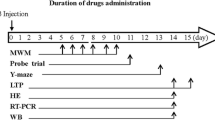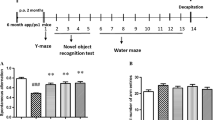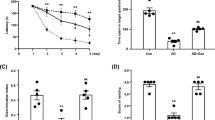Abstract
Alzheimer’s disease (AD) is a neurodegenerative disorder characterized by extracellular deposits of fibrillary β-amyloid (Aβ) plaques in the brain that initiate an inflammatory process resulting in neurodegeneration. The neuronal loss associated with AD results in gross atrophy of affected regions causing a progressive loss of cognitive ability and memory function, ultimately leading to dementia. Growing evidence suggests that vasoactive intestinal peptide (VIP) could be beneficial for various neurodegenerative diseases, including AD. The study investigated the effects of VIP on 5xFAD, a transgenic mouse model of AD. Toward this aim, we used 20 5xFAD mice in two groups (n = 10 each), VIP-treated (25 ng/kg i.p. injection, three times per week) and saline-treated (the drug’s vehicle) following the same administration regimen. Treatment started at 1 month of age and ended 2 months later. After 2 months of treatment, the mice were euthanized, their brains dissected out, and immunohistochemically stained for Aβ40 and Aβ42 on serial sections. Then, plaque analysis and stereological morphometric analysis were performed in different brain regions. Chronic VIP administration in 5xFAD mice significantly decreased the levels of Aβ40 and Aβ42 plaques in the subiculum compared to the saline treated 5xFAD mice. VIP treatment also significantly decreased Aβ40 and Aβ42 plaques in cortical areas and significantly increased the hippocampus/cerebrum and corpus callosum/cerebrum ratio but not the cerebral cortex/cerebrum ratio. In summary, we found that chronic administration of VIP significantly decreased Aβ plaques and preserved against atrophy for related brain regions in 5xFAD AD mice.




Similar content being viewed by others
References
Aytan N, Choi JK, Carreras I, Crabtree L, Nguyen B, Lehar M, Blusztajn JK, Jenkins BG, Dedeoglu A (2018) Protective effects of 7,8-dihydroxyflavone on neuropathological and neurochemical changes in a mouse model of Alzheimer's disease. Eur J Pharmacol 3 828:9–17
Bayer TA, Wirths O, Majtényi K, Hartmann T, Multhaup G, Beyreuther K, Czech C (2001) Key factors in Alzheimer's disease: beta-amyloid precursor protein processing, metabolism and intraneuronal transport. Brain Pathol 11(1):1–11, 1
Bertram L, Lill CM, Tanzi RE (2010) The genetics of Alzheimer disease: back to the future. Neuron 68(2):270–281
Brenneman DE (1988) Regulation of activity-linked neuronal survival by vasoactive intestinal peptide. Ann NYAcad Sci 527:595–597
Brenneman DE, Gozes I (1996) A femtomolar-acting neuroprotective peptide. J Clin Invest 97(10):2299–2307
Carreras I, McKee AC, Choi JK, Aytan N, Kowall NW, Jenkins BG, Dedeoglu A (2013) R-flurbiprofen improves tau, but not Aß pathology in a triple transgenic model of Alzheimer’s disease. Brain Res 1541:115–127
Choi JK, Carreras I, Aytan N, Jenkins-Sahlin E, Dedeoglu A, Jenkins BG (2014) The effects of aging, housing and ibuprofen treatment on brain neurochemistry in a triple transgene Alzheimer’s disease mouse model using magnetic resonance spectroscopy and imaging. Brain Res 1590:85–96
Delgado M, Varela N, Gonzalez-Rey E (2008) Vasoactive intestinal peptide protects against beta-amyloid-induced neurodegeneration by inhibiting microglia activation at multiple levels. Glia 56(10):1091–1103
Deng G, Jin L (2017) The effects of vasoactive intestinal peptide in neurodegenerative disorders. Neurol Res 39(1):65–72
Dogrukol-Ak D, Banks WA, Tuncel N, Tuncel M (2003) Passage of vasoactive intestinal peptide across the blood-brain barrier. Peptides 24(3):437–444
Ge S, Sailor KA, Ming GL, Song H (2008) Synaptic integration and plasticity of new neurons in the adult hippocampus. J Physiol 586(16):3759–3765
Gonzales-Reyes R, Nava-Mesa MO, Vargas-Sanches K, Ariza-Salamanca D, Mora-Munoz L (2017) Involvement of astrocytes in Alzheimer’s disease from a neuroinflammatory and oxidative stress perspective. https://doi.org/10.3389/fnmol.2017.00427
Gouras GK1, Olsson TT, Hansson O (2015) β-Amyloid peptides and amyloid plaques in Alzheimer’s disease. Neurotherapeutics 12(1):3–11
Gozes I, Bardea A, Reshef A, Zamostiano R, Zhukovsky S, Rubinraut S, Fridkin M, Brenneman DE (1996) Neurobiology neuroprotective strategy for Alzheimer disease: intranasal administration of a fatty neuropeptide. Proc Natl Acad Sci U S A 93:427–432
Han P, Caselli RJ, Baxter L, Serrano G, Yin J, Beach TG, Reiman EM, Shi J (2015) Association of pituitary adenylate cyclase-activating polypeptide with cognitive decline in mild cognitive impairment due to Alzheimer disease. JAMA Neurol 72(3):333–339
Han P, Tang Z2, Yin J et al. (2014) Pituitary adenylate cyclase-activating polypeptide protects against β-amyloid toxicity. Neurobiol Aging ;35(9):2064–2071
Hardy J (2002) Testing times for the “amyloid cascade hypothesis”. Neurobiol Aging 23(6):1073–1074
Harmar AJ, Arimura A, Gozes I, Journot L, Laburthe M, Pisegna JR, Rawlings SR, Robberecht P, Said SI, Sreedharan SP, Wank SA, Waschek JA (1998) International Union of Pharmacology. XVIII. Nomenclature of receptors for vasoactive intestinal peptide and pituitary adenylate cyclase-activating polypeptide. Pharmacol Rev 50(2):265–270
Hill JM, Hauser JM, Sheppard LM, Abebe D, Spivak-Pohis I, Kushnir M, Deitch I, Gozes I (2007) Blockage of VIP during mouse embryogenesis modifies adult behaviour and results in permanent changes in brain chemistry. J Mol Neurosci 31(3):183–200
Hill JM, Mervis RF, Politi J, McCune SK, Gozes I, Fridkin M, Brenneman DE (1994) Blockade of VIP during neonatal development induces neuronal damage and increases VIP and VIP receptors in brain. Ann N Y Acad Sci 739:211–225
Incerti M, Vink J, Roberson R, Benassou I, Abebe D, Spong CY (2010) Prevention of the alcohol-induced changes in brainderived neurotrophic factor expression using neuroprotective peptides in a model of fetal alcohol syndrome. Am J Obstet Gynecol 202(5):457 e1–4
Jan YN, Jan LY (2003) The control of dendrite development. Neuron 40(2):229–242
Kalaria RN (1999) Microglia and Alzheimer’s disease. Curr Opin Hematol 6(1):15–24
Korkmaz O, Ay H, Ulupinar E, Tunçel N (2012) Vasoactive intestinal peptide enhances striatal plasticity and prevents dopaminergic cell loss in Parkinsonian rats. J Mol Neurosci 48(3):565–573
Kowall NW, Hantraye P, Brouillet E, Beal MF, McKee AC, Ferrante RJ (2000) MPTP induces alpha-synuclein aggregation in the substantia nigra of baboons. Neuroreport 11(1):211–213
Lindberg O, Mårtensson G, Stomrud E, Palmqvist S, Wahlund LO, Westman E, Hansson O (2017) Atrophy of the posterior subiculum is associated with memory impairment, tau- and Aβ pathology in non-demented individuals. Front Aging Neurosci 9:306
Magarinos AM, Li CJ, Gal TJ et al (2011) Effect of brain-derived neurotrophic factor haploinsufficiency on stress-induced remodelling of hippocampal neurons. Hippocampus 21(3):253–264
McDonald DR, Bamberger ME, Combs CK, Landreth GE (1998) Beta-amyloid fibrils activate parallel mitogen-activated protein kinase pathways in microglia and THP1 monocytes. J Neurosci 18(12):4451–4460
McGeer EG, McGeer PL (1998) The importance of inflammatory mechanisms in Alzheimer disease. Exp Gerontol 33(5):371–378
McGeer EG, McGeer PL (1999) Brain inflammation in Alzheimer disease and the therapeutic implications. Curr Pharm Des 5(10):821–836
Meraz-Ríosv MA, Toral-Rios D, Franco-Bocanegra D, Villeda-Hernández J, Campos-Peña V (2013) Inflammatory process in Alzheimer’s disease. Front Integr Neurosci 7:59
Nunan R, Sivasathiaseelan H, Khan D, Zaben M, Gray W (2014) Microglial VPAC1R mediates a novel mechanism of neuroimmune-modulation of hippocampal precursor cells via IL-4 release. Glia 62(8):1313–1327
Oakley H, Cole SL, Logan S, Maus E, Shao P, Craft J, Guillozet-Bongaarts A, Ohno M, Disterhoft J, Van Eldik L, Berry R, Vassar R (2006) Intraneuronal beta-amyloid aggregates, neurodegeneration, and neuron loss in transgenic mice with five familial Alzheimer's disease mutations: potential factors in amyloid plaque formation. J Neurosci 26(40):10129–10140
Onoue S, Endo K, Ohshima K, Yajima T, Kashimoto K (2002) The neuropeptide PACAP attenuates beta-amyloid (1-42)-induced toxicity in PC12 cells. Peptides 23(8):1471–1478
Onoue S, Waki Y, Nagano Y, Satoh S, Kashimoto K (2001) The neuromodulatory effects of VIP/PACAP on PC-12 cells are associated with their N-terminal structures. Peptides 22(6):867–872
Pellegri G, Magistretti PJ, Martin JL (1998) VIP and PACAP potentiate the action of glutamate on BDNF expression in mouse cortical neurones. Eur J Neurosci 10(1):272–280
Philipson O, Lord A, Gumucio A, O'Callaghan P, Lannfelt L, Nilsson LN (2010) Animal models of amyloid-beta-related pathologies in Alzheimer’s disease. FEBS J 277(6):1389–1409
Rangon CM, Dicou E, Goursaud S et al (2006) Mechanisms of VIP induced neuroprotection against neonatal excitotoxicity. Ann N Y Acad Sci 1070:512–517
Rat D1, Schmitt U, Tippmann F et al. (2012) Neuropeptide pituitary adenylate cyclase-activating polypeptide (PACAP) slows down Alzheimer’s disease-like pathology in amyloid precursor protein-transgenic mice. FASEB J 25(9):3208–3218
Redwine JM, Kosofsky B, Jacobs RE, Games D, Reilly JF, Morrison JH, Young WG, Bloom FE (2003) Dentate gyrus volume is reduced before onset of plaque formation in PDAPP mice: a magnetic resonance microscopy and stereologic analysis. Proc Natl Acad Sci U S A 100(3):1381–1386
Smith-Swintosky VL, Gozes I, Brenneman DE, D'Andrea MR, PlataSalaman CR (2005) Activity-dependent neurotrophic factor-9 and NAP promote neurite outgrowth in rat hippocampal and cortical cultures. J Mol Neurosci 25(3):225–238
Solito E, Sastre M (2012) Microglia function in Alzheimer’s disease. Front Pharmacol 3:14
Song M, Xiong JX, Wang YY, Tang J, Zhang B, Bai Y (2012) VIP enhances phagocytosis of fibrillar beta-amyloid by microglia and attenuates amyloid deposition in the brain of APP/PS1 mice. PLoS One 7(2):e29790
Stranahan AM (2011) Physiological variability in brain-derived neurotrophic factor expression predicts dendritic spine density in the mouse dentate gyrus. Neurosci Lett 9;495(1):60-62
Villoslada P, Moreno B, Melero I et al (2008) Immunotherapy for neurological diseases. Clin Immunol 128(3):294–305
Weldon DT, Rogers SD, Ghilardi JR, Finke MP, Cleary JP, O'Hare E, Esler WP, Maggio JE, Mantyh PW (1998) Fibrillar beta-amyloid induces microglial phagocytosis, expression of inducible nitric oxide synthase, and loss of a select population of neurons in the rat CNS in vivo. J Neurosci 18(6):2161–2173
Xie Z, Wei M, Morgan TE, Fabrizio P, Han D, Finch CE, Longo VD (2002) Peroxynitrite mediates neurotoxicity of amyloid beta-peptide1-42- and lipopolysaccharide-activated microglia. J Neurosci 22(9):3484–3492
Yelkenli IH, Ulupinar E, Korkmaz OT, Şener E, Kuş G, Filiz Z, Tunçel N (2016) Modulation of corpus striatal neurochemistry by astrocytes and vasoactive intestinal peptide (VIP) in parkinsonian rats. J Mol Neurosci 59(2):280–289
Zaben M, Sheward WJ, Shtaya A, Abbosh C, Harmar AJ, Pringle AK, Gray WP (2009) The neurotransmitter VIP expands the pool of symmetrically dividing postnatal dentate gyrusprecursors via VPAC2 receptors or directs them toward a neuronal fate via VPAC1 receptors. Stem Cells 27(10):2539–2551
Zhang QL, Liu J, Lin PX, Webster HD (2002) Local administration of vasoactive intestinal peptide after nerve transection accelerates early myelination and growth of regenerating axons. J Peripher Nerv Syst 7:118–127
Acknowledgements
The authors thank to Lokman Hossain for animal husbandry.
Funding
This research is supported by grants from NIA (R01AG031896, RF1AG056032) and the Department of Veteran Affairs (Merit Award; 5I01BX001875-03) to A. Dedeoglu and P30AG013846 to NW Kowall, and Scientific and Technical Research Council of Turkey (TUBITAK, 1059B190900502) to O.T. Korkmaz.
Author information
Authors and Affiliations
Corresponding author
Ethics declarations
Conflict of Interest
The authors declare that they have no competing interests.
Additional information
Publisher’s Note
Springer Nature remains neutral with regard to jurisdictional claims in published maps and institutional affiliations.
Rights and permissions
About this article
Cite this article
Korkmaz, O.T., Ay, H., Aytan, N. et al. Vasoactive Intestinal Peptide Decreases β-Amyloid Accumulation and Prevents Brain Atrophy in the 5xFAD Mouse Model of Alzheimer’s Disease. J Mol Neurosci 68, 389–396 (2019). https://doi.org/10.1007/s12031-018-1226-8
Received:
Accepted:
Published:
Issue Date:
DOI: https://doi.org/10.1007/s12031-018-1226-8




